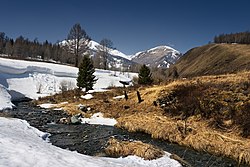Katonkaragay District
Appearance
(Redirected from Katonkaragay)
Katonkaragay | |
|---|---|
District | |
| Катонқарағай ауданы Катон-Карагайский район | |
 Kara-Koba River, Markakol Nature Reserve | |
 | |
| Coordinates: 49°12′41″N 84°30′50″E / 49.2113°N 84.5138°E | |
| Country | |
| Region | East Kazakhstan Region |
| Administrative center | Katonkaragay |
| Founded | 1928 |
| Government | |
| • Akim | Calican Dildar Kalikanovich[1] |
| Area | |
| • Total | 13,167 km2 (5,084 sq mi) |
| Population (2013)[2] | |
| • Total | 28,008 |
| Time zone | UTC+6 (East) |
| Saka kurgans[3] | ||||||||||||||||||||||||||||||
|---|---|---|---|---|---|---|---|---|---|---|---|---|---|---|---|---|---|---|---|---|---|---|---|---|---|---|---|---|---|---|
|
||||||||||||||||||||||||||||||
Katonkaragay, also spelled Katon-Karagay (Kazakh: Қатонқарағай ауданы, romanized: Qatonqarağai audany) is a district of East Kazakhstan Region in eastern Kazakhstan. The administrative center of the district is the selo of Katonkaragay.[4] It is the easternmost district in Kazakhstan. Population: 28,008 (2013 estimate);[2] 30,056 (2009 Census results);[5] 45,149 (1999 Census results).[5]
Berel burial mound
[edit]Near the selo of Berel (49°22′24″N 86°26′17″E / 49.3732082°N 86.4380264°E[6]) excavations of ancient burial mounds have revealed artefacts the sophistication of which are encouraging a revaluation of the nomadic cultures of the 3rd and 4th centuries BC.[7]
References
[edit]- ^ "Акимат Катон-Карагайского района". www.gov.kz.
- ^ a b "Население Республики Казахстан" (in Russian). Департамент социальной и демографической статистики. Retrieved 27 December 2013.
- ^ Image file with complete data, Amir, Saltanat; Roberts, Rebecca C. (2023). "The Saka 'Animal Style' in Context: Material, Technology, Form and Use". Arts. 12: 23. doi:10.3390/arts12010023.
- ^ "Subdivisions of Kazakhstan in local languages". Geonames.de. Archived from the original on 2016-03-03. Retrieved 2014-02-28.
- ^ a b "Население Республики Казахстан" [Population of the Republic of Kazakhstan] (in Russian). Департамент социальной и демографической статистики. Retrieved 8 December 2013.
- ^ [1] Archived June 23, 2007, at the Wayback Machine
- ^ Wilford, John Noble (12 March 2012). "Artifacts Show Sophistication of Ancient Nomads". The New York Times. Retrieved 2014-03-01.
External links
[edit]




